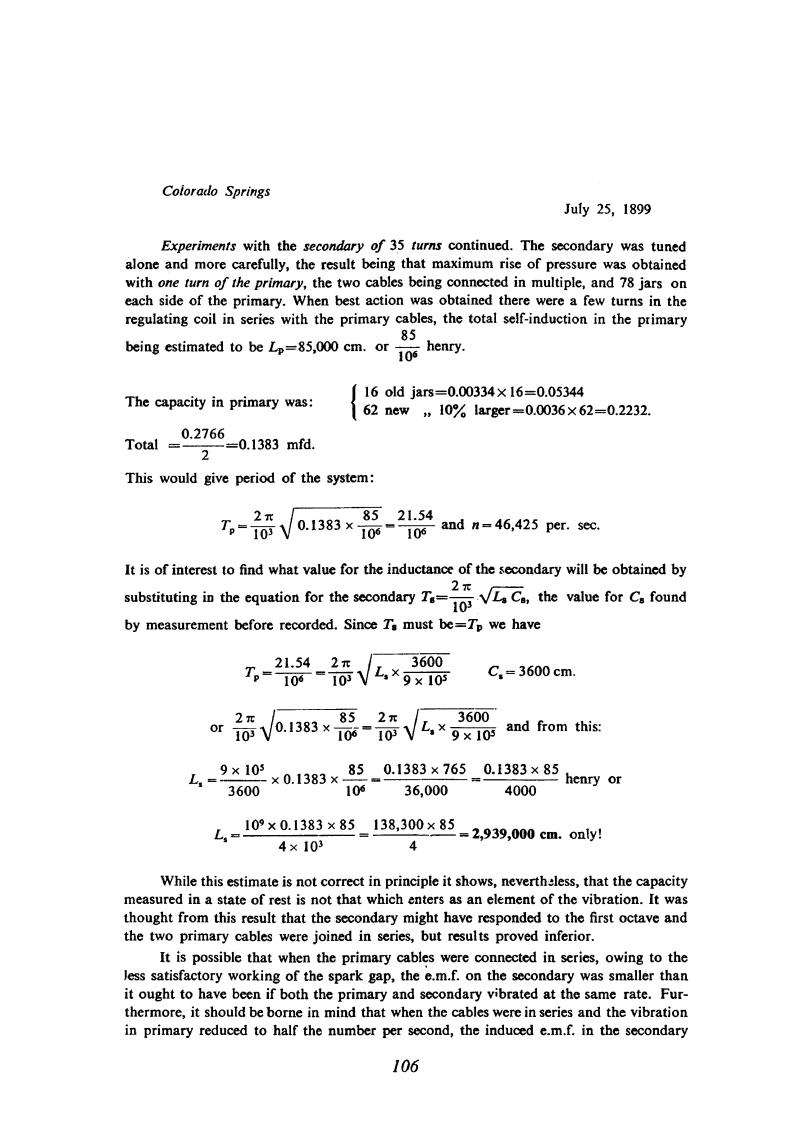
Nikola Tesla Books
Colorado Springs
July 25, 1899
Experiments with the secondary of 35 turns continued. The secondary was tuned alone and more carefully, the result being that maximum rise of pressure was obtained with one turn of the primary, the two cables being connected in multiple, and 78 jars on each side of the primary. When best action was obtained there were a few turns in the regulating coil in series with the primary cables, the total self-induction in the primary being estimated to be Lp = 85,000 cm. or $! {85 \over 10^{6}} $! henry.
The capacity in primary was: { 16 old jars = 0.00334 x 16 = 0.0534462 new jars 10% larger = 0.0036 x 62 = 0.2232.
Total = $! {0.2766 \over 2} $! = 0.1383 mfd.
This would give period of the system:
$! {T_{p} = {{2 \pi \over 10^{3}} \sqrt{{0.1383 \times {85 \over 10^{6}}}}} = {21.54 \over 10^{6}}} $! and n = 46,425 per. sec.
It is of interest to find what value for the inductance of the secondary will be obtained by substituting in the equation for the secondary $! {T_{s} = {{2 \pi \over 10^{3}} \sqrt{L_{s} C_{s}}}} $!, the value for Cs found by measurement before recorded. Since Ts must be = Tp we have
$! {T_{p} = {21.54 \over 10^{6}} = {{2 \pi \over 10^{3}} \sqrt{L_{s} \times {3600 \over {9 \times 10^{5}}}}}} $! Cs = 3600 cm.
or $! {{{2 \pi \over 10^{3}} \sqrt{0.1383 \times {85 \over 10^{6}}}} = {{2 \pi \over 10^{3}} \sqrt{L_{s} \times {3600 \over {9 \times 10^{5}}}}}} $! and from this:
$! {L_{s} = {{{9 \times 10^{5} \over 3600}} \times 0.1383 \times {85 \over 10^{6}}} = {{0.1383 \times 765} \over 36,000} = {{0.1383 \times 85} \over 4000}} $! henry or
$! {L_{s} = {{10^{9} \times 0.1383 \times 85} \over {4 \times 10^{3}}} = {{138,300 \times 85} \over 4}} $! = 2,939,000 cm. only!
While this estimate is not correct in principle it shows, nevertheless, that the capacity measured in a state of rest is not that which enters as an element of the vibration. It was thought from this result that the secondary might have responded to the first octave and the two primary cables were joined in series, but results proved inferior.
It is possible that when the primary cables were connected in series, owing to the less satisfactory working of the spark gap, the e.m.f. on the secondary was smaller than it ought to have been if both the primary and secondary vibrated at the same rate. Furthermore, it should be borne in mind that when the cables were in series and the vibration in primary reduced to half the number per second, the induced e.m.f. in the secondary
106
July 25
In continuation of work with the secondary, he attempts to match the theoretical calculations with experimental results. As he did in the past, he adjust the capacitance and inductance in the primary circuit so that oscillator operates the best. Under these operating conditions he determines the primary circuit parameters and on the basis of them finds the primary circuit self-resonant frequency. He considers that his oscillator operating frequency, and on the basis of it the secondary capacitance as well (measured on the previous day) determines the secondary inductance. This rough estimate, of which Tesla says it is incorrect, he made, it appears only to convince himself that static coil capacitance is not the element which appears in the oscillator dynamic operation regime. He did some checking, and by reducing the oscillator operating frequency in half (by introducing a primary with two turns instead of one by which method the primary inductance was increased four times), he concluded that the secondary coil capacitance has probably a lower value than the one which he found by previous measurements in another operating regime.

